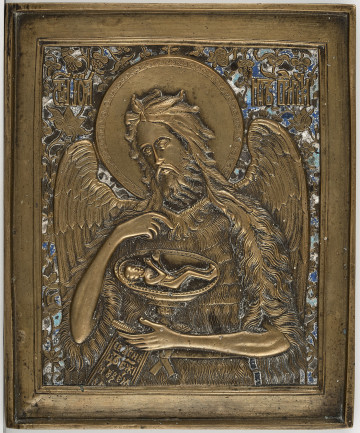
St. John the Baptist
20th century
Castle Museum in Łańcut
Part of the collection: Icons
Crucifixion, silhouette icon In Rus, the cross was one of the most important objects of Christian cult. Following the example of the imports from Byzantium, local products began to be made. Among them, there was no shortage of crosses of various sizes, shapes, and purposes made of metal alloys. From the end of the 17th c. until the 20th c. in Russia, their production was dominated by the Old Believers, persecuted because of their rejection of the liturgical reform introduced in the middle of the 17th c. The silhouette relief icon of a cross with the depiction of the Crucified Christ remained one of the most popular products used by Old Believers and by those faithful to the official doctrine of the Orthodox Church alike (see S.12789MŁ – 12795MŁ; S.12869MŁ; S.12870MŁ; S.12872MŁ – 12876MŁ). In Rus, eight-pointed crosses with three crossbeams became entrenched (see S. 12875MŁ). Not only the details of the portrayals were important - so were the inscriptions which accompanied them (see S.12793MŁ). On the displayed cross, the triple identification of the person of the Saviour is worth noting. On the upper crossbeam, above Christ's head, the abbreviation 'ІНЦИ' stands for the crime of the condemned man written down by Pilate - "Jesus of Nazareth, Tsar (King) of the Jews". Above the middle crossbeam, there is the abbreviation of Christ's name, ICXC, and the text 'СНЬ БЖІЙ' - Son of God. The placement of the heavenly bodies at the hands of the Saviour is not accidental. The Sun (СЛНЦЕ) by his right hand and the Moon (ЛУНА) by his left are to be read as an illustration of the text of the Gospels (Matthew 27:45), as well as symbols of the continuity of the Ecclesia (the Church) and the Synagogue - continuity of the Old and the New Covenant, completed by the sacrifice of the cross. Among the details accompanying depictions of the Crucifixion, there are the instruments of torment, including the spear which pierced the side of the Saviour - marked with the letter K for 'kopije' - and the reed with a vinegar-soaked sponge which was offered to Christ - marked with the letter T for 'trost' (Matthew 27:48, Mark 15:36, John 19:29-30, 34-35). Teresa Bagińska-Żurawska https://orcid.org/0000-0002-9243-3967
Dimensions
height: 19 cm, width: 10.4 cm
Object type
Icons
Technique
cast
Material
brass
Origin / acquisition method
decyzja administracyjna
Creation time / dating
Creation / finding place
Owner
Castle Museum in Łańcut
Identification number
Location / status

20th century
Castle Museum in Łańcut

19th (?) century
Castle Museum in Łańcut

1800 — 1850
Castle Museum in Łańcut
DISCOVER this TOPIC
Castle Museum in Łańcut
DISCOVER this PATH
Educational path